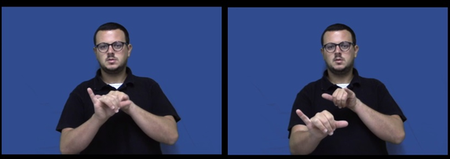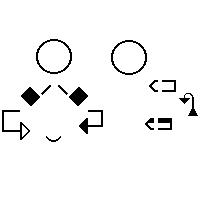Bitħa Yard
Hemm verżjoni waħda ta' dan is-sinjal. Agħfas il-buttuni hawn taħt biex tara l-istampi, il-kitba u l-vidjow.
There is one version of this sign. Use the butttons below to view the photographs, signwriting and video.
Hemm żewġ sinjali differenti għal BITĦA. L-ewwel sinjal isir biż-żewġ idejn forma ta’ Y bil-pala tħares ’l isfel. L-idejn jitqiegħdu lura, id quddiem id. L-id ta’ wara tibqa’ fil-post waqt li l-id l-oħra timxi ’l quddiem sakemm id-driegħ ikun iddritta.
It-tieni sinjal għandu żewġ partijiet, is-sinjal għal KAMRA u s-sinjal għal WARA. (i) Is-sinjal għal KAMRA jsir billi l-werrej ta’ id waħda jmiss il-werrej tal-id l-oħra quddiem is-sider. Dawn jersqu fil-ġenb imbagħad lura biex jiffurmaw angolu rett. (ii) It-tieni parti issir billi id waħda tieħu l-forma ta’ 5 magħluq, bil-pala tal-id tħares ’l isfel jew ’il ġewwa. Din l-id tieqaf quddiem is-sider waqt li l-id l-oħra tieħu l-forma ta’ 5 milwi jew ta’ 1. L-ewwel id togħla ’l fuq imbagħad timxi ’l quddiem u terġa tinżel qisu qed tindika il-wara ta’ bini li huwa rappreżentat mill-id wieqfa.
There are two different signs for YARD. The first sign is made with both hands in the shape of Y with palms facing downwards. The hands are placed at the back, one in front of the other. The hand at the back stays in place whilst the other hand moves as far forward as possible until the arm is held in a straight line.
The second sign consists of two parts, the sign for ROOM and the sign for BEHIND. (i) The sign for ROOM is made with the index fingers touching in front of the chest and then moving away to the side and then to the back in order to form a right angle. (ii) The second part is made with one hand in the shape of closed 5 with palm facing downwards or inwards. The hand is held stationary at chest level whilst the other hand takes the shape of bent 5 or of 1. This hand moves up and well over the other hand then down again as though it is indicating the back of a building represented by the stationary hand.




